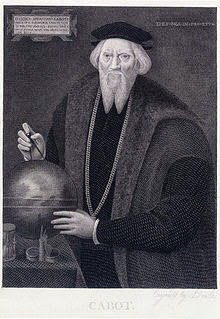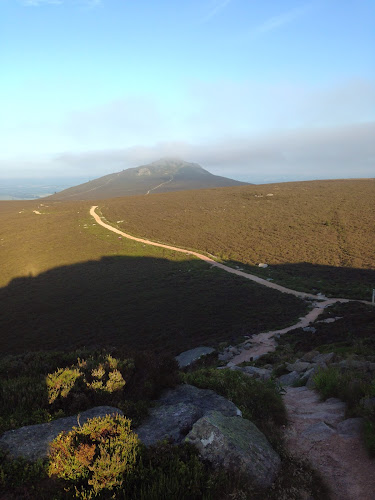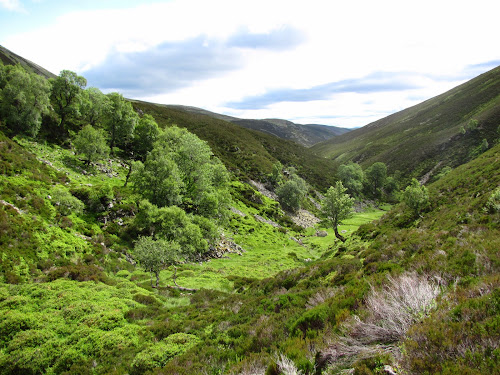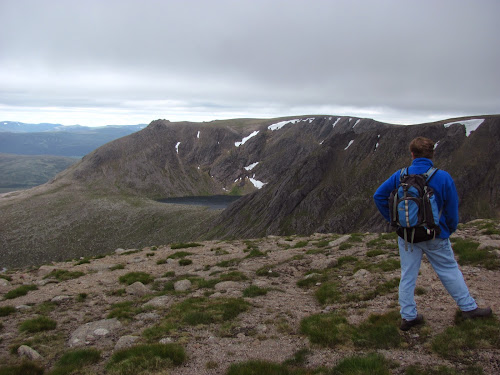Alex and I had planned to visit Bute for a weekend of walking and relaxation earlier in the year but other commitments had got in the way. Taking this to probably be my last chance to get a micro-adventure in for 2014 we viewed the weather forecast after a week of dull skies and rain and decided to make an effort to fly across to Bute last Friday and to stay at Alex’s holiday home for the weekend before flying back on Sunday.
The weather in Aberdeen on Friday morning was much better than at any time over the past 2 weeks. Nevertheless there was still a lot of moisture in the air with an easterly wind off the North Sea. This meant that we could fly VFR to Bute but we would certainly encounter a good bit of unstable cumulus on the 1st leg between Aberdeen and Perth.
Meeting up at 0700 we were at the Airfield before the early morning traffic became too busy. This gave us plenty of time to prep the aircraft and ensure fuel tanks were brim full. Tie-down pickets were placed in the back of the aircraft and bags loaded in the bag – along with 4 pints of Ossian Ale we were taking along for Saturday Evening’s pre-entertainment something to be drunk whilst watching a couple of episodes of Blake’s Seven.
We decided that this time Alex would fly the leg out and I would fly the return leg so for now I could relax and enjoy the view. Take off was at 0815 and we were on our way via Loch of Skene towards Perth. With plenty of moisture in the air there was low lying fog in the Dee Valley around Banchory and we went into Cumulus after Alex had requested higher clearance (to 4000’) which we were not to emerge from until almost at Perth.
From Perth the weather improved markedly with not a cloud in the sky for the rest of the journey and superb views in all directions. We routed south of Auchterarder’ in order to avoid any possible parachutists at Strathallan, to Loch Lomond and then vie Helensburgh to Bute coming down to 3000’ and eventually to 2000’ as we arrived at Bute. Views over the island were excellent although there was haze to the South and Arran, though close, was mostly obscured from view by mist and haze – we knew there was a warm front approaching and due to reach Bute by 1400 so suspected there was a lot of moisture in the air ahead of the front which was obscuring views to the south.
Before landing we flew over Port Bannatyne (where Alex’s holiday home is located) and then circumnavigated the island anti-clockwise flying between Bute and the small island of Inchmarnock to the west. After overflying the airfield to assess wind direction and length of grass (to confirm we would get out again!) Alex landed us on RW 09 at 1020. As we exited the aircraft we found the source of the disconcerting creaking noise we had been intermittently hearing all the way – the end strap of Alex’s rucsac had been trapped in the door and slapping the side of the plane in our slipstream.
This arrival time was too early to get lunch at the Kingarth Hotel so we took the path from the airfield through woods and past some still fruiting Blackberry bushes, to Kilchattan Bay – the tiny village at below the bay that names it. Here we went into the Post Office and had a mug of coffee each whilst chatting to Trish – who was looking after the shop for now. In just 20 minutes we obtained a wealth of local gossip – noting with sadness that there had been 3 funerals in this tiny place in the previous week. It was not all bad though as we found out that the young German shepherdess who lived in the farm outside the village was a champion sheep dog breeder and had sold one of her latest pups to someone in America and she was baking a cake. We met this young lady herself and she was a delight to talk to. The honesty of Island folk was also attested to as someone who had found a wallet lying in the road brought it into the PO whilst we were there and was able to find the wallet’s owner. We were enjoying this microcosm of island life but an event of greater importance was looming – it was opening time at the Kingarth. So quickly back to the airfield to collect our kit from ZV then the short walk past the graveyard and into the Kingarth Hotel for 2 pints of real ale and a lunch of lentil soup followed by the ‘Kingarth Burger’ (2 x burgers in a Ciabatta with onions, relish and Stilton) - there are other things on the menu but I can never see past the burger! By 1300 we were replete and able to catch the bus into Rothesay the island capital where we could grab some supplies and catch up on local news at Brechins. The bus ride takes only 20 mins or so from the Kingarth.
In Rothsaay we grabbed more food – a scone - and a Coffee at Brechins which is a Coffee Shop/Restaurant/Music Shop! The owner is instrumental, if you’ll excuse the pun, in organising the annual Bute Jazz festival and is an active musician in the West of Scotland music scene – this was to catch us out in the evening when we were trying to find a good eatery only to find that the Restaurant was closed that evening due to the owner having a Musical Engagement. Still for now it was a fine place to stop before catching the bus on into Port Bannatyne.
On reaching Alex’s place we sorted out our kit, took a walk along the shore in the gathering gloom and then the rain (from the advancing front, started initially quite heavily. ‘Hobgoblin?’ said I as we passed one of 3 pubs in the Port (one of these opens only rarely – local rumour being that the owner is a retired MI6 agent). The pub we stopped at was next to the Post Office and has recently been bought – we certainly found the new owners to be very friendly and providing some fine bottled ales (Hobgoblin gold being my choice for now) with plans to take in some of the New Bute Brewery cask ales when the brewery is able to ramp up production.
View from the house on Saturday morning
After a couple of pints we wandered back to the house and got ready to walk back into Rothesay for dinner at ‘The Waterfront’ which is a delightful eatery, serving excellent food, opposite the ferry terminal. The walk is around 35 mins so we arrived wet and hungry only to find that this week The Waterfront was closed, never mind let’s try Brechins. As I have already said this too was shut. After wandering around for a bit more in the rain – finding Harry Haw’s full – we decided we can’t go wrong with an Indian so entered the ‘Prince of India’ and were proved wrong. It appears you can go wrong with an Indian! Well we ate and then grumpily walked back to the Port to watch some Blake’s Seven and drink the Ossian before retiring
After heavy overnight rain we woke up to find low cloud outside so plan for the Day was to take a walk into town for Brunch in the morning after which we could pick up some bacon for Sunday’s breakfast and then in the afternoon to follow the West Island Way to the fine beach at Ettrick Bay. In Rothesay we found a scone and coffee in Brechins was sufficient to satisfy our hunger and enjoyed the walk into town and back.

At this time of year the sun sets early so we got going quickly in the afternoon to walk to Ettrick bay. The 1st part of the walk follows the West Island Bay with the last mile or so separating from the walk. As we approached the Bay the sun was low on the horizon and the cloud form the morning was breaking up. The beach was clear of people except for one man who was walking his Alsatian and Scotty Terrier – these dogs racing after each other in and out of the sea. A heron was trying to fish but gave up after being chased once too often by the Alsatian. For our part, we retired to the Café at the beach for a piece of Victoria sponge and a coffee. Some discussion was had on which rout to take back to Port Bannatyne but given the gathering gloom and our dark clothing the longer route which would bring us out on a pathless road was decided against and instead we took the same route back as we had used to get to the bay.
Given our inability to find an eatery on Friday night we were a bit glum about our chances for Saturday, but what the heck we’d walk back to Rothesay. Well Alex had managed somehow to miss the Excellent Ghillies restaurant on Friday night we found it right next door to the Prince of India – the site of so much disappointment on Friday! Here we got a table for 2 no bother – the table in the corner was crowded with several ladies of our era who seemed to be enjoying a few bottles of ‘old lady petrol’ (white wine) and were having a whale of a time. In addition there were several others in the room. The Restaurant had a ground floor and a 1st floor – we stayed on the former and were glad of it as just as we finished our starters (Scallops with Black Pudding and Prawns – to die for) the 13yr old Beth Swan and her parents arrived and for the rest of the evening we were all entertained by Beth’s excellent singing – both accompanied by her father and solo. Beth was an amazingly confident young woman and sang with great gusto. We ended up staying to listen to her for a good 2 hours after we had finished our meal. Beth has a Facebook page – ‘Beth Swan Sings’ – for anyone interested in finding out more.

Eventually we had to leave to walk back, in fact given our extended stay at the restaurant it was more of a stagger than a walk. Nevertheless we did get back and managed a final episode of Blake’s Seven to end a very peasant evening.
Sunday dawned bright and still. We knew that Friday’s weather front had cleared into the North Sea by now and we would easily get back to Aberdeen in great weather. All we had to do was to wait for the Sunday service Bus to take us back to the Kingarth. A gentle stroll to the Port in the morning was followed by Bacon sandwiches and packing up of kit. The Bus arrived at 1255 and we were back at the airfield in plenty of time to pre-flight and a final ‘pit-stop’ occaisioned by Friday’s dodgy curry. This was my leg and despite the grass of the airstrip being very wet we were airborne (this time from 27) by the time we had covered ½ the length of the runway. There was some cloud at about 1800ft as we headed west so I levelled at 1500ft and given excellent visibility all round decided to circumnavigate Arran before setting route for home.
At Arran the hill tops were a good 1000’ above us but we had great views of the 3 Corbetts and of the Witch’s Step. Aas we got to the southern end of the island I had to descend to 1000’ due to a squall but on setting course for Bute again the cloud cleared completely and I climbed ZV to 2000’. Bute itself was cloud free. Although there was some low cloud covering Glasgow it was not on our track and as we cleared Loch Lomond the cloud disappeared entirely for the rest of the rout allowing a climb to 4000’. Again we steered clear of Strathallan where this time we knew for certain that parachutists were active. From Perth we headed direct to Loch of Skene – bisecting the gap between Mt Battock and Clach naBen on the way. After an hour and a half of flying in fantastic early winter sunshine we touched down (annoyingly long ) just before sunset at Aberdeen.














































